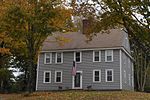Whittenton Mills Complex

The Whittenton Mills Complex is a historic textile mill site located on Whittenton Street in Taunton, Massachusetts, on the banks of the Mill River. The site has been used for industrial purposes since 1670, when James Leonard built an iron forge on the west bank of the river. The first textile mill was built in 1805 and expanded throughout the 19th century. The complex was added to the National Register of Historic Places in 1984, and now contains various small businesses. In October 2005, the site gained national attention when the mill's 1832 wooden dam threatened to collapse after heavy rains. More than 2,000 people were evacuated for several days while officials and work crews could shore up the dam with boulders. As of 2012, there is an effort underway to have the dam removed entirely, and allow for restoration of the river bed.In 2008, scenes from the Martin Scorsese film Shutter Island, portraying the Dachau concentration camp were filmed here.
Excerpt from the Wikipedia article Whittenton Mills Complex (License: CC BY-SA 3.0, Authors, Images).Whittenton Mills Complex
Whittenton Street, Taunton
Geographical coordinates (GPS) Address Nearby Places Show on map
Geographical coordinates (GPS)
| Latitude | Longitude |
|---|---|
| N 41.924166666667 ° | E -71.105833333333 ° |
Address
Whittenton Street 437
02780 Taunton
Massachusetts, United States
Open on Google Maps









